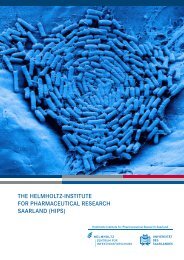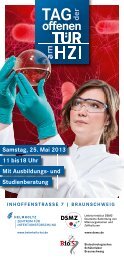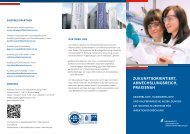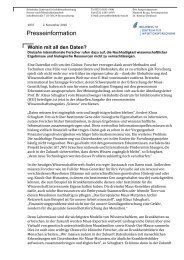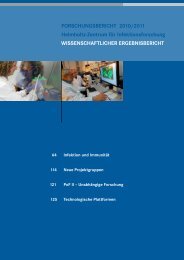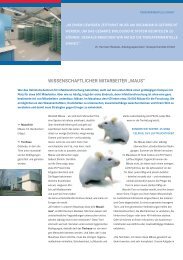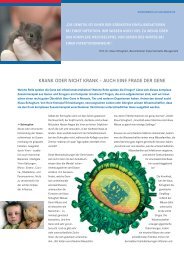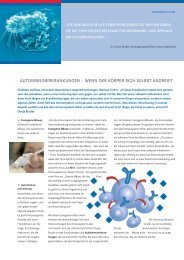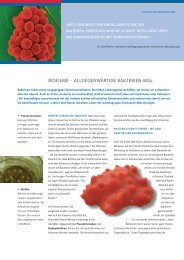Research Report 2010 2011 - Helmholtz-Zentrum für ...
Research Report 2010 2011 - Helmholtz-Zentrum für ...
Research Report 2010 2011 - Helmholtz-Zentrum für ...
Create successful ePaper yourself
Turn your PDF publications into a flip-book with our unique Google optimized e-Paper software.
38 RESEARCH REVIEWS | Novel Nanoparticle-based Technology Platform for the Delivery of Vaccine Antigens<br />
particles. 11 In addition, it was shown that carrier size could<br />
play a role in determining the type of response induced.<br />
Virus-like particles induced IFN-γ and cell-mediated type<br />
1 responses, whereas larger beads mostly induced type 2<br />
responses. 12<br />
However, strategies for transdermal vaccination that reduce<br />
the protective barrier function of the stratum corneum for a<br />
significant period of time are intrinsically problematic due<br />
to the risk of invasion of pathogens. This imposes a limit to<br />
such methods for mass vaccination campaigns in countries<br />
with critical hygienic conditions and calls for alternatives<br />
that leave the stratum corneum intact. Therefore, the transappendage<br />
pathway seems to be an appealing alternative to<br />
circumvent the stratum corneum barrier and directly target<br />
Langerhans cells via the hair follicles.<br />
Fig 3. Overlay of transmission and fluorescence image of<br />
a longitudinal section of skin from a porcine ear. Green<br />
fluorescent nanoparticles (ca. 500 nm) applied to the ear<br />
accumulate in the opening of the hair follicle. Photo: HZI<br />
Development of pollen-mimetic vaccine particles<br />
Scientists from HIPS and Saarland University, in collaboration<br />
with the Charité Universitätsmedizin Berlin¸<br />
recently showed that nanoparticles accumulate selectively<br />
in the openings of hair follicles. 13 These nanoparticles were<br />
made of the biodegradable and biocompatible polymer<br />
polylactic-co-glycolic acid (PLGA) using polyvinyl alcohol<br />
as a stabilizer.<br />
A plain aqueous nanoparticle suspension as well as a<br />
hydrogel formulation that was massaged into pig ear skin<br />
in vitro, permeated deeper and to a greater extent into hair<br />
follicles than an aqueous solution applied with similar<br />
physical force. It was hypothesized that this is due to a passive<br />
targeting effect, elicited by the nano-scale size of the<br />
delivery device. We could further show that such particles<br />
may release different encapsulated compounds that then<br />
enter the stratum corneum.<br />
As outlined above, the trans-follicular route appeals as a<br />
very attractive and safe strategy for the delivery of vaccine<br />
antigens to APCs. Hair bulbs are also an excellent reservoir,<br />
being only slowly cleared by hair growth and sebum production.<br />
16 An activation of the APCs via this route is a commonly<br />
occurring phenomenon in allergic contact dermatitis<br />
in people allergic to pollen antigens. In fact, pollen can be<br />
considered as a micrometer sized carrier that accumulates<br />
in the follicle opening, sebaceous gland or dermatoglyphs<br />
(skin folds). Antigen release from the pollen is triggered by<br />
a moist atmosphere with sufficient humidity, such as occurs<br />
on the skin by sweating. The idea is now to mimic pollen<br />
delivery in order to vaccinate across the intact skin barrier.<br />
Therefore, we are currently working to create pollen-mimetic<br />
carriers allowing antigens to be stably encapsulated in<br />
order to target the hair follicles. This would allow releasing<br />
the antigen at the site of action in a controlled fashion in<br />
order to activate skin APCs, thereby eliciting an effective<br />
humoral and cellular immune responses. Co-encapsulation<br />
of different adjuvants would enable to strengthen the<br />
overall responses, as well as to modulate them according to<br />
the specific needs. First experiments show that the model<br />
antigens can be encapsulated into PLGA particles. These<br />
particles can be freeze-dried to be stored in a stable form.<br />
They can then be re-dispersed in water directly before the<br />
experiment to be tested in vitro or in vivo. The particles shall<br />
later be formulated as a gel or lotion making them easy to<br />
manufacture, acceptable to patients and safe to use.



